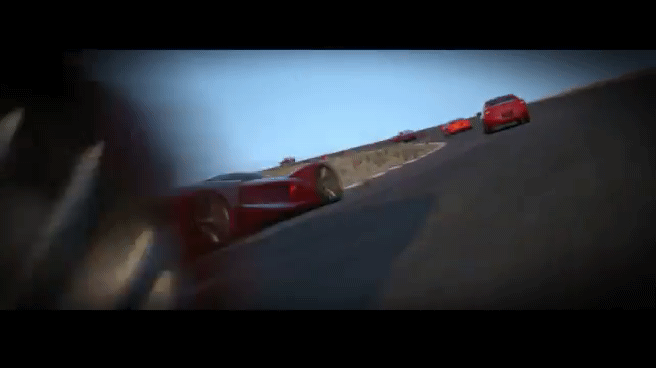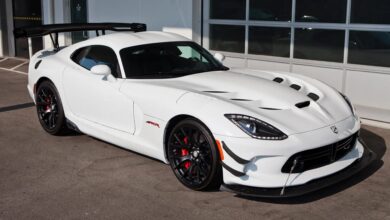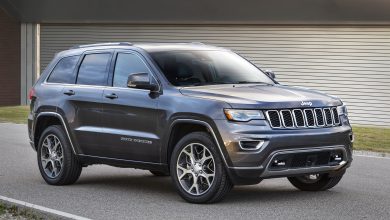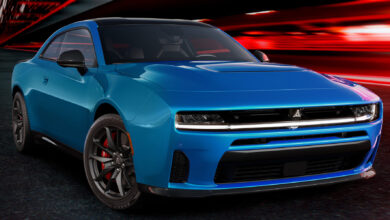
Back in June of 2015, the Dodge//SRT Design Studio in Auburn Hills, Michigan showed off their idea of the ultimate supercar from 20 years in the future with the SRT Tomahawk Vision Gran Turismo. The concept was a single-seat concept that pulled from existing and potential technologies to test the limits of performance. The car was made as a downable addition to the popular Gran Turismo 6® (GT6) video game racing simulator for the PlayStation®3 console. So let’s take a look at the wild design that made up, this futuristic mid-engine creation.

The SRT Tomahawk Vision Gran Turismo launched as part of the Vision Gran Turismo project where automakers, design houses, and leading brands around the globe showcased special concept vehicles exclusively in GT6.
The extreme exterior look of the SRT Tomahawk Vision Gran Turismo was born from an internal design competition that sought a futuristic (2035) interpretation of a high-performance Dodge. But this single-seat car was more than just a digital design fantasy.

“It doesn’t take much to bring out the competitive spirit of the FCA US design team,” said Ralph Gilles, Head of Stellantis Design. “We have plenty of Gran Turismo fans in the room and every one of them has the same goal – win the race. Everything we’ve done with the SRT Tomahawk Vision Gran Turismo aims for that goal.”

The popularity of video games among the members of the Dodge//SRT Design Studio meant that giving the GT6 assignment to one person or one studio was not an option. Everyone, from interns to seasoned designers, was invited to submit a sketch. As a result, designers worked on their sketches in their spare time, on weekends, and after-hours producing a flood of proposals. At the conclusion of the judging process, Paul Hoste (former Stellantis designer who now works for the electric car company Rivian) was selected as the winner. Hoste, grew up playing Gran Turismo. He was inspired by concept art and gravitated toward a design that had amped-up, voluptuous curves that paid homage to iconic Dodge performance vehicles.

The overall shape of the SRT Tomahawk Vision Gran Turismo imparts a sense of movement and flow. The front view conveyed an aggressive, almost menacing character, while the rear view took on a bolder and more powerful aesthetic with angular graphics and an asymmetric look to the fenders. All of the transparent elements, including the cockpit and engine cover, were made from ultra-light graphene skins. The driver could view the SRT Tomahawk Vision Gran Turismo’s instruments and communication system on a clear digital overlay on the graphene windshield.

A large air intake for engine cooling was mounted on the hood. Active panels mounted above the front and rear fenders could constantly move, via pneumatic assist, to create the optimal amount of aerodynamic downforce for braking assist and traction under acceleration. An overhead view of the SRT Tomahawk Vision Gran Turismo was marked by a “pinched-waist” silhouette. An exposed aluminum spine channels air helped cool the V-10 engine.
Curved, voluptuous surfacing was used to create a timeless design that was accented by functional NACA-style air intakes on the front and large air intakes for engine and brake cooling on the side.

The rear of the SRT Tomahawk Vision Gran Turismo has been thoughtfully designed for high impact, as it was the primary view for the gamer (and his or her competitors) during play. A bold, carbon fiber graphic detail was prominent. Thin LED lights and five large exhaust ports were integrated into the rear diffuser to create an intimidating and planted look. Hoste worked closely with SRT engineering to optimize the hard points and performance numbers of his design for function and aerodynamics.

With a full set of engineering and performance specifications developed by the SRT engineering team at FCA US, the capabilities of the SRT Tomahawk Vision Gran Turismo were rooted in an effort to push performance just beyond the limits of known science. The entire vehicle design, from the driver position to the nearly flat layout of the V-10 engine, was intended to achieve the lowest possible center of gravity. The SRT Tomahawk Vision Gran Turismo was engineered and developed to the same uncompromising standards as any SRT vehicle on the road today. SRT engineers also worked in their spare time and on weekends to create three extremely fast cars that test the limits of human physiology.

“We had fun stretching our minds to create the SRT Tomahawk Vision Gran Turismo for GT6. The game places a high emphasis on capturing reality in a virtual environment; our goal was to respect that philosophy by focusing on plausible future technologies that could achieve our vision of extreme performance,” said Mike Shinedling, Manager – Advanced Concepts, SRT Engineering, FCA US LLC. “Everyone can appreciate an exquisite design and something that is beautifully engineered; when those two things are brought together in a fusion of cooperation, there is nothing more exciting.”
Key engineering features of the SRT Tomahawk Vision Gran Turismo included:
- Ultra-lightweight materials used in the chassis and bodywork result in a car that weighs just 1,658 pounds in its ultimate performance configuration – just slightly heavier than a current-day Formula One race car.
- Rear wheels were powered by a wide-angle (144 degrees) V-10 engine that theoretically delivers up to 2,168 horsepower.
- Front wheels were pneumatically driven independently. Combined with the V-10 powertrain, the SRT Tomahawk Vision Gran Turismo theoretically produces up to 2,590 hp. Maximum performance version the SRT Tomahawk Vision Gran Turismo rolls with 1.56 hp per pound.
- In addition to the front-wheel power unit, pressurized air drove fast-actuating aerodynamic body panels for enhanced braking/traction performance, and activates the driver’s G-suit during extreme maneuvers. Pressurized air could be stored in tanks integrated into SRT Tomahawk Vision Gran Turismo’s chassis to negate any weight penalty.
The SRT Tomahawk Vision Gran Turismo comes in three variations:
- Entry-level S: Game players had to first master the base version of the SRT Tomahawk Vision Gran Turismo. The 7.0-liter wide-angle V-10 was tuned to deliver 792 horsepower (compared with 645 horsepower for the 8.4-liter V-10 in the 2013 to 2017 Dodge Viper). The pneumatically driven front wheels added 215 horsepower, for a total system output of 1,007 horsepower. With a curb weight of 2,026 pounds, this version of the SRT Tomahawk Vision Gran Turismo is the heaviest, yet it has a top speed in excess of 250 mph.
- Racing version GTS-R: Race tuning pushes the output of the V-10 to 1,137 horsepower, while the air-driven front wheels added 313 horsepower for a total system output of 1,450 horsepower. Aggressive weight-cutting techniques whittle the curb weight of the Tomahawk Vision Gran Turismo GTS-R to 1,459 pounds (the lightest of any version) and the top speed in excess of 300 mph.
- Experimental technology ultimate version X: This is the ultimate Tomahawk Vision Gran Turismo. With a redline set at 14,500 rpm, the V-10 engine theoretically produced 2,168 horsepower (nearly three times the output from the base Tomahawk Vision Gran Turismo S). The front-wheel drivetrain contributed an additional 422 horsepower at peak, for a total output of 2,590 horsepower. That gave the Tomahawk Vision Gran Turismo X a theoretically top speed of 404 mph. Due to the extreme performance of the X version, the driver would be required to wear a G-suit for protection.

The single-seat, mid-engine, all-wheel-drive SRT Tomahawk Vision Gran Turismo used a purpose-built composite chassis. The chassis used emerging and advanced materials, including hollow carbon nanofibers and graphene micro-lattice structures. Filament-wound pneumatic cylinders were integral structural elements laminated into the chassis. To assist in cooling the carbon brake discs, the pneumatic front power unit could build up a “chill-sink” with expanding air during power delivery. This chill-sink was used to deliver required brake cooling with a minimal amount of airflow, thus greatly reducing aerodynamic drag.

In order to withstand the massive cornering and downforce loads, next-generation compounds and construction were used to create the tires. The onboard pneumatic system could continuously monitor and adjusts tire pressures according to the vehicle’s demands.

While the V-10 engine drives the rear wheels, the SRT Tomahawk Vision Gran Turismo’s front wheels were linked to a variable-fin quad-stage pneumatic power unit that can quickly store and release energy. When the Tomahawk Vision Gran Turismo’s brakes were activated, or the V-10 engine was not at max power, the pneumatic power unit compressed air into the long, composite tanks that were structural members of the chassis. The compressed air was released to drive the front wheels, power the Tomahawk Vision Gran Turismo active aero panels, and pressurize the driver’s G-suit in the Tomahawk Vision Gran Turismo X.

Pneumatic energy was generated in three ways:
- Pre-race full charge
- Braking re-generation charge via independent power units at each front wheel
- Engine charge during braking and as part of the stability control system. During hard corner exit and launch acceleration, when wheel spin is detected, excess available power is pulled from the engine via a third power unit

Pneumatic energy was released in five primary ways:
- Front-wheel drive
- Fast actuation of aerodynamic panels
- Charging the variable spring rate suspension system
- Wake modification for low drag, high speed runs on long straights (Nordschleife Dottinger-Hohe, Mulsanne Straight, Bonneville Salt Flats/LSR)
- Pressurization of driver G-suit

SRT engineers called for an aggressive aerodynamic strategy to manage airflow at extreme speeds. The Tomahawk Vision Gran Turismo’s aerodynamic system reacts to inputs from a forward scanning laser system that detects surface changes. The computer controls anticipate changes in vehicle ride height, pitch, and yaw and adjust the splitter accordingly.
The SRT Tomahawk Vision Gran Turismo not only generates a tremendous amount of downforce, but it also generated yaw force, normally seen in aircraft. There are nine active aerodynamic panels and two front splitters that actively steer the car through the air and help the vehicle corner at extreme speeds. These aerodynamic features were constantly adjusting to track conditions and driver inputs in order to provide the highest level of downforce when needed. However, in a top-speed run, the panels could be tucked to create a slippery, low-drag shape.

The V-10’s exhaust system was routed to the rear diffuser in a series of paired runners. Flow from the exhaust worked in conjunction with the active aerodynamic system to provide an acceleration of underbody flow at the rear of the car and created a blown diffuser effect that increased downforce without a negative effect on drag.
Pneumatics also drove the Tomahawk Vision Gran Turismo’s suspension. The car rode on a set of variable-rate pneumatic springs with adjustable jounce and rebound damping. A revolutionary active camber system could adjust the wheel knuckles to “lean” the vehicle into turns, with each wheel angling outboard or inboard to maintain the optimum tire contact patch and highest possible mechanical grip.

While the SRT Tomahawk Vision Gran Turismo was just a fun idea inside the Dodge//SRT design studio and engineering teams, it showed just how innovative the teams are. It also displayed how car designers and engineers are looking into the future for some unique ideas to propel the auto industry forward.
What did you think of the Tomahawk Vision Gran Turismo Concept? Let us know in the comments below.
Source: Dodge//SRT
SRT Tomahawk Vision Gran Turismo Image Gallery:

































